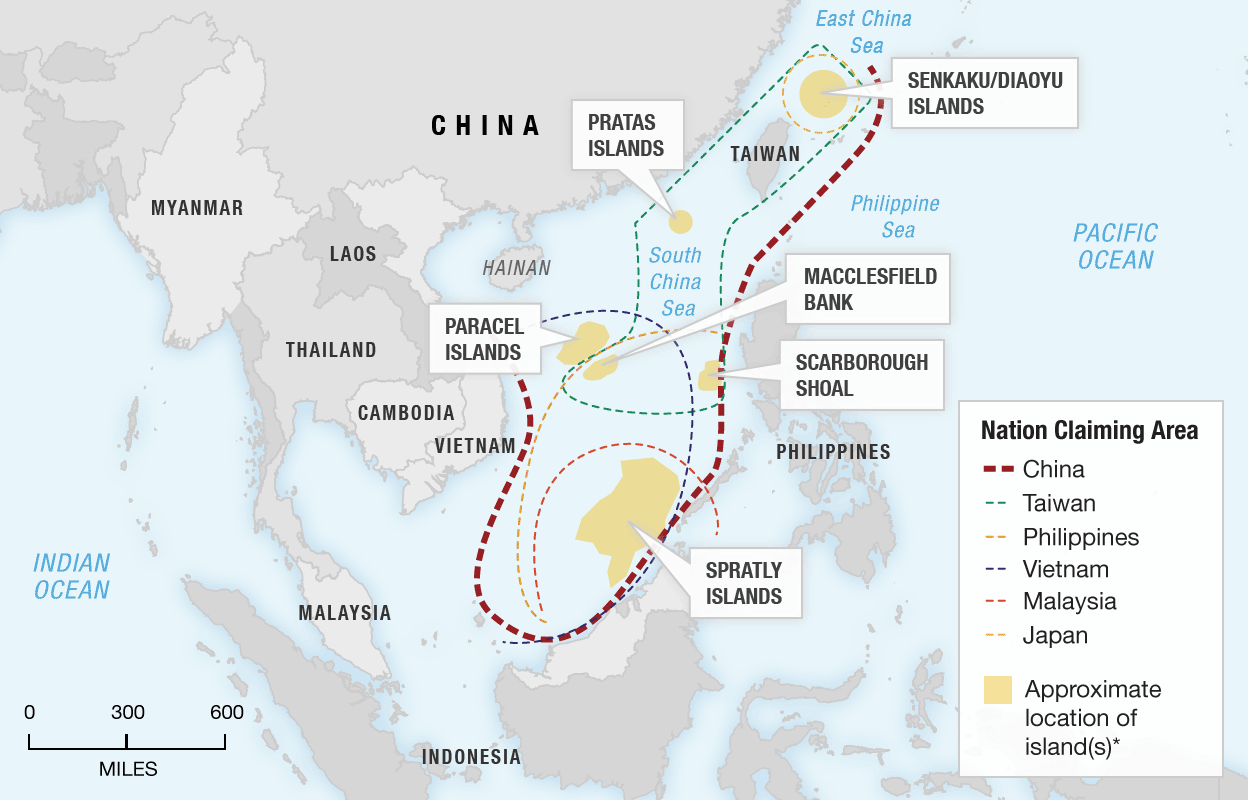U.S., Japan, India and Philippines challenge Beijing with naval drills
Daily News Article — Posted on May 10, 2019
(by Caitlin Doornbos, Stars and Stripes) – The U.S. on Wednesday finished a weeklong sail through the South China Sea with India, Japan and the Philippines, a region fraught with tension amid disputed territorial claims, according to a Navy statement Thursday.
The guided-missile destroyer USS William P. Lawrence joined the Indian navy destroyer INS Kolkata and tanker INS Shakti; Japan Maritime Self-Defense Force helicopter carrier JS Izumo and destroyer JS Murasame; and Philippine navy patrol ship BRP Andres Bonifacio in international waters May 2-8.
The six vessels gathered “to train together and promote maritime cooperation throughout a free and open Indo-Pacific,” the Navy said in the statement.
The ships practiced “formation exercises, communication drills, passenger transfers and held a leadership exchange aboard JS Izumo” during the exercise, according to the statement.
The region is important to trade and rich in natural resources. Five nations — China, Malaysia, the Philippines, Vietnam and Taiwan — have overlapping claims to almost 70 reefs and islands in the South China Sea, according to the Center for Strategic and International Studies Asia Maritime Transparency Initiative.
The…exercise follows a U.S. request in December that its Pacific allies boost their military presence in the South China Sea. China continues to claim and militarize reefs and islands in the region, contrary to a 2016 decision by a United Nations tribunal.
China has created 3,200 new acres of land in the sea’s Spratly Islands since 2013, building artificial land masses for military outposts, according to the center.
Last year, China placed “anti-ship cruise missiles and long-range surface-to-air missiles on outposts in the Spratly Islands,” according to a report on China’s military power published last week by the U.S. Defense Department.
In response to the report, China Foreign Ministry spokesman Geng Shuang said at a press briefing Monday that “China pursues peaceful development and a defense policy that is defensive in nature,” according to a transcript.
Randy Schriver, assistant U.S. Secretary of Defense for Asian and Pacific affairs, in an interview with The Australian newspaper in December, proposed bringing more pressure on the Chinese by having “other partners and allies joining in these activities” in the South China Sea.
“If not freedom-of-navigation operations … just joint patrols, presence operations,” he added, according to The Australian.
Freedom-of-navigation operations challenge territorial claims and are often conducted by sending ships within 12 nautical miles of a disputed land mass.
Days before the four-nation exercise began, the USS William P. Lawrence sailed the Taiwan Strait with the guided-missile destroyer USS Stethem April 28, irking China.
William P. Lawrence commanding officer Cmdr. Andrew Klug said working with Pacific allies strengthens international partnerships.
“Professional engagements with our allies, partners and friends in the region are opportunities to build upon our existing, strong relationships, as well as learn from each other,” Klug said in the Navy statement.
JMSDF Rear Adm. Hiroshi Egawa, commander of Escort Flotilla 1, said the four-country exercise “built mutual understanding and trust” and “enhance[d] peace and stability in the Indo-Pacific region,” according to the Navy statement.
“The ability to do various exercises among four different navies smoothly demonstrated professionalism and high operational skills,” Egawa said in the statement.
Background
What is the South China Sea? (from Australia's New Daily)
- The South China Sea is a critical commercial gateway for a large portion of the world’s merchant shipping.
- It is bordered by Brunei, Cambodia, China, Indonesia, Malaysia, the Philippines, Singapore, Taiwan, Thailand and Vietnam.
- China claims almost all of the strategic South China Sea with Brunei, Indonesia, Malaysia, the Philippines, Taiwan and Vietnam pushing competing claims to parts of the maritime region.
- China has been militarizing the region for several years now. In 2018, China placed anti-ship cruise missiles and long-range surface-to-air missiles on the contested Spratly Islands, according to a recent Pentagon report.
- The US, Japan and India do not have any territorial claims there.
- For more information on the South China Sea and its geo-political importance, the Lowy Institute has an excellent overview. (includes map)
Since 2014, China has forged ahead with island-building in the disputed waters of the South China Sea, despite a landmark ruling in 2016 by the Permanent Court of Arbitration in The Hague, which said there was no legal basis for China’s maritime claims.
China’s claims to the South China Sea stretch roughly 1,000 miles from its southern shores, pitting it against Taiwan, the Philippines, Brunei, Malaysia, and Vietnam.
High-resolution aerial images of China’s reclamation efforts in the Spratly Islands show that the reefs and sandbars have been turned into island fortresses, with ports, air strips, lighthouses, hangars and multi-story buildings.
Under US President Donald Trump and his predecessor, President Barack Obama, the US has conducted “freedom of navigation” operations, sailing military vessels and flying planes close to islands China controls, often triggering heated warnings from Chinese patrols.
But it has done little to rein in China’s expansionism in the South China Sea.
“The US does need to take a consistent and perhaps more assertive approach to how to deal with this advancement,” said Admiral Kirby.
“I do not think it’s too late to forestall further militarization, but I think we need to have a comprehensive — and not just a military — strategy for how to deal with this.” (from a March 6, 2018 report at SND)
Read South China Sea at the Law of the Sea wikipedia entry.

